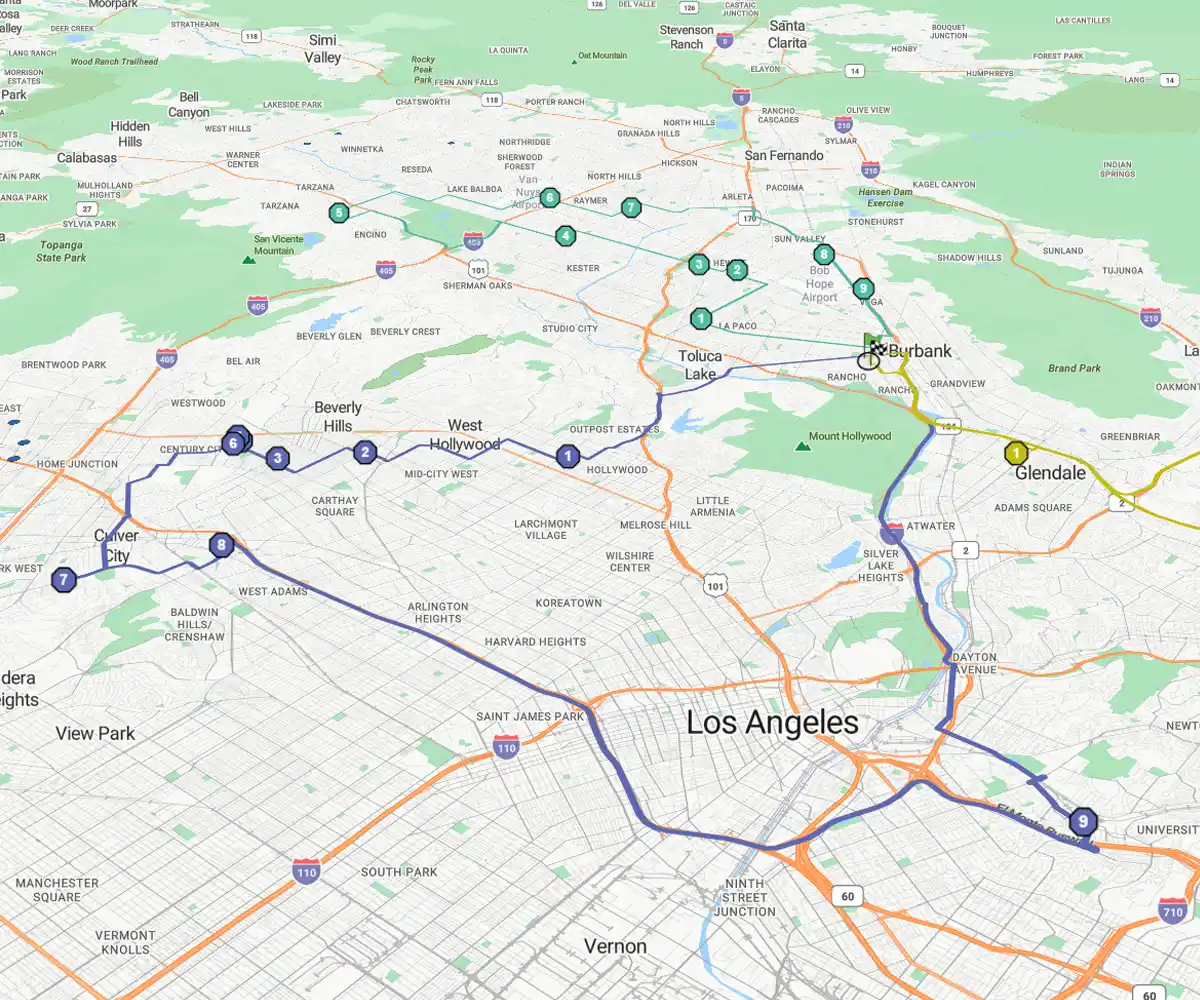Quick answer
To optimize sales route planning, visualize sales data, prioritize high-value customers, and use mapping tools to generate efficient, multi-stop routes. Real-time adjustments, CRM integration, and mobile access help reps stay productive and adapt quickly in the field.
Optimizing sales routes is one of the fastest ways to boost productivity, cut costs, and maximize customer face time. This guide shows how modern tools like eSpatial can transform your planning process from manual guesswork to smart, data-driven efficiency.
What is Sales Route Planning?
Sales route planning, or sales route optimization, is the process of organizing traveling to multiple stops in the shortest amount of time for salespeople. When this is done with a specialized route planner, the process becomes quite simple.
Why Sales Route Planning Matters
For salespeople, the time spent selling to prospects and customers is directly linked to quota achievement. According to a Forbes study titled "Why Sales Reps Spend So Little Time Selling", only 35% of a sales rep's time is spent selling to customers. Every minute regained through sales route planning and optimization is time you can spend with customers.
The key benefits of sales route planning are:
-
More time spent with "high-profit" customers (or Sweet Spot Clients)
-
Less windshield time (or drivetime)
-
More selling time
-
Higher productivity and revenue
Step-by-step Guide to Optimize Sales Routes
So, how do you optimize sales route planning with mapping tools? It may sound complex, but it doesn’t have to be. Follow this step-by-step guide to streamline your sales route planning, reduce travel time, and boost productivity in the field.
Step 1
Import and Organize Sales Data
Easily import and organize sales data and turn raw information into actionable insights:
- Upload Excel spreadsheets or connect CRM systems to bring in customer, lead, and territory data
- Automatic geocoding maps your data by converting addresses or postcodes into exact map locations
- Categorize and filter data by fields like account type, deal value, priority, or rep assignment
- Interactive visualization of data through pin maps, heat maps, and territory layers
- When integrated with CRM platforms, sales data stays up-to-date
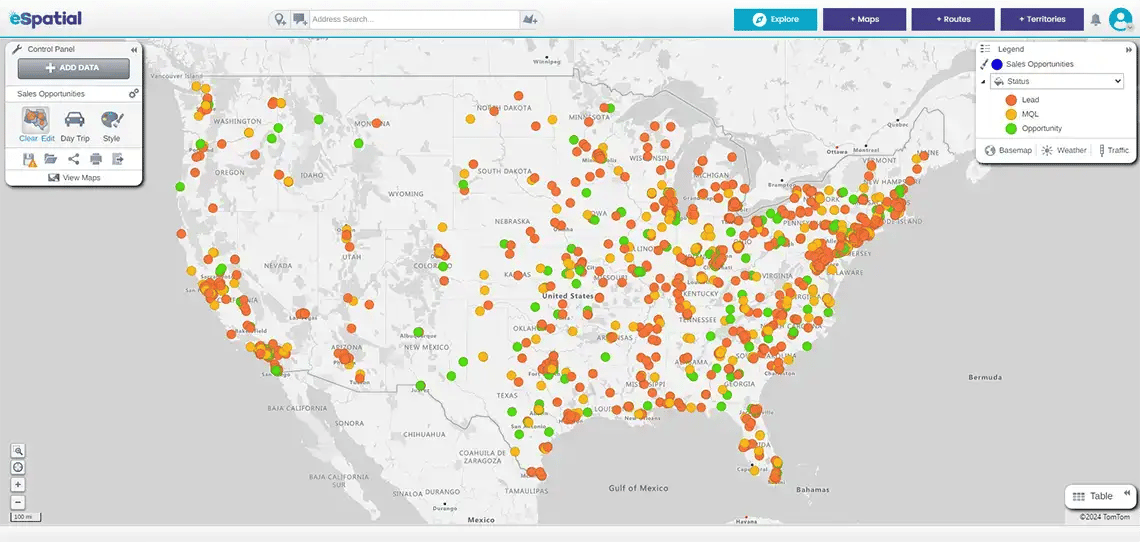
Step 2
Map Customer and Prospect Locations
Learning how to plan a sales route starts with deep knowledge of your sales territory and geography. This requires solid data on your customers, prospects, and competitor locations. When you optimize field sales route planning to help create a sales strategy, seeing those locations can be transformational.
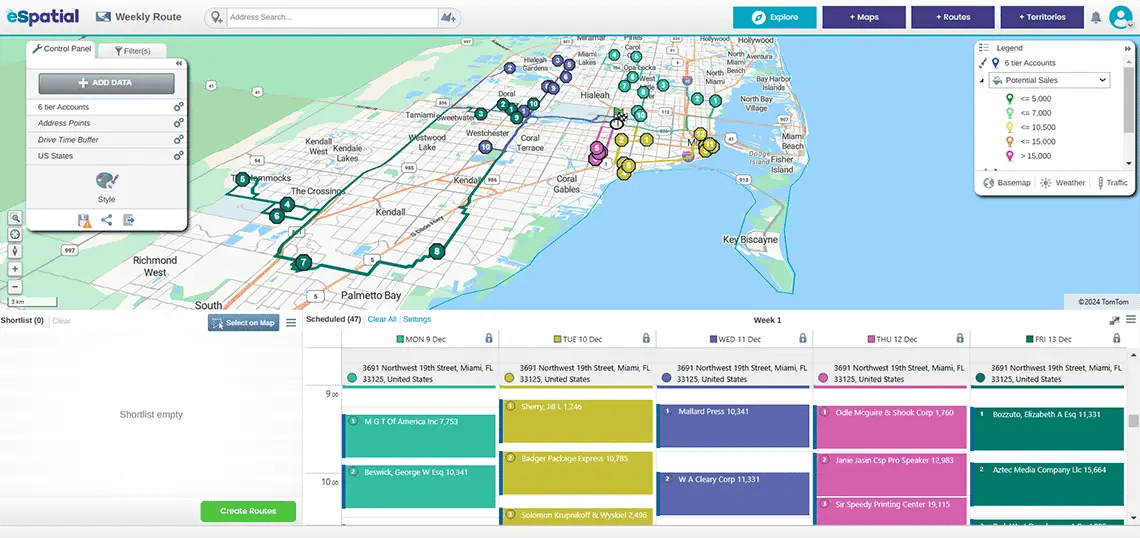
Your sales data will come alive as you uncover patterns like competitor clusters or customer hotspots. You will also see whitespaces or areas with untapped sales potential, which is important if you want to optimize sales territories.
Step 3
Prioritize Visits Based on Sales Value
Sales strategy execution is always a priority, but often behaviors misalign with the objectives. For example, your strategy is to sell premium security systems to households with a minimum income of $200,000. But analysis of sales rep calls shows that they are calling on households with average incomes below $100,000. It is a common challenge.
Before you proceed with sales route optimization, be clear on your Sweet Spot Client—a customer with the highest profitable sales potential.
Ask these questions:
- Which industry and or group of organizations should you prioritize?
- What size are they? (revenue, employees, patients, PCs)
- What personas own the benefits?
- What will be their key drivers to enable them to say yes?
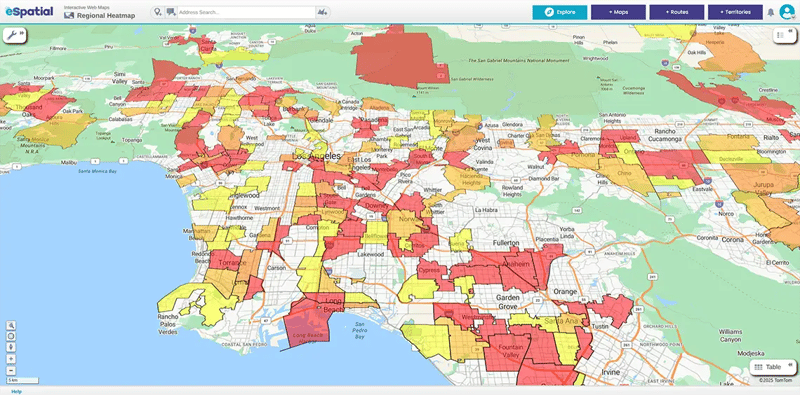
Step 4
Use Mapping Tools to Optimize the Route
By combining territory data, locked appointments, and intelligent sales route optimization, reps work smarter (not harder). Here’s how mapping tools optimize the route:
- Visualize customer locations: Pin and heat maps reveal where high-priority clients, prospects, and competitors are concentrated, helping reps understand territory dynamics at a glance.
- Prioritize and lock in key meetings: Schedule must-attend appointments (like high-value clients or time-sensitive visits) first, then allow the system to generate optimal routes around these fixed points.
- Reduce travel time, boost productivity: Advanced algorithms minimize drive time and mileage, enabling one extra customer visit per day and maximizing selling hours.
Step 5
Enable Real-time Adjustments
With eSpatial's mapping software for sales, you can re-optimize dynamically on the go. Sales reps can quickly adjust their routes in real time to add calls or reshuffle stops. They can search for replacement calls on a map and select, or hit re-optimize, and be back on schedule in minutes.
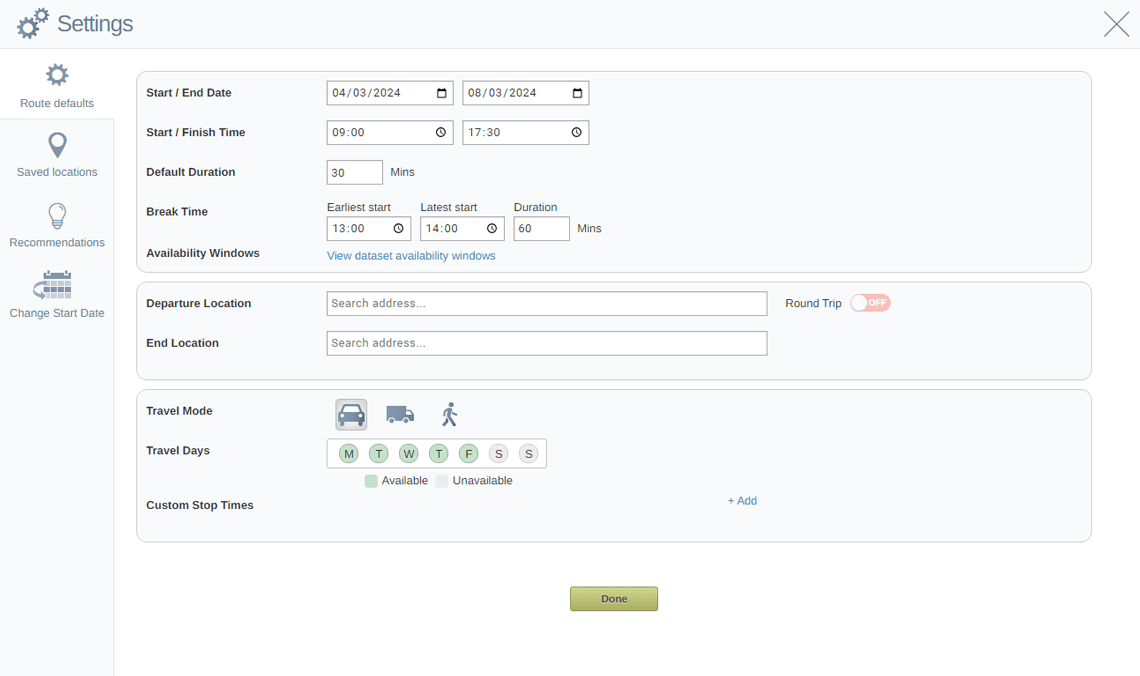
Step 6
Capture Field Data and Sync With CRM
Real-time tracking of rep visits, such as locations checked in, time spent, and meeting outcomes, captures data around field activity. Reps can also log details like meeting notes, next steps, and opportunity status directly in-field through the mobile app.
eSpatial mapping software easily integrates with CRM systems like Salesforce. Sales reps can access and update lead or account information directly through the interface while on the road. CRM data can inform smarter routing decisions based on opportunity size, last contact date, or customer priority, creating a closed loop between the field and the back office.
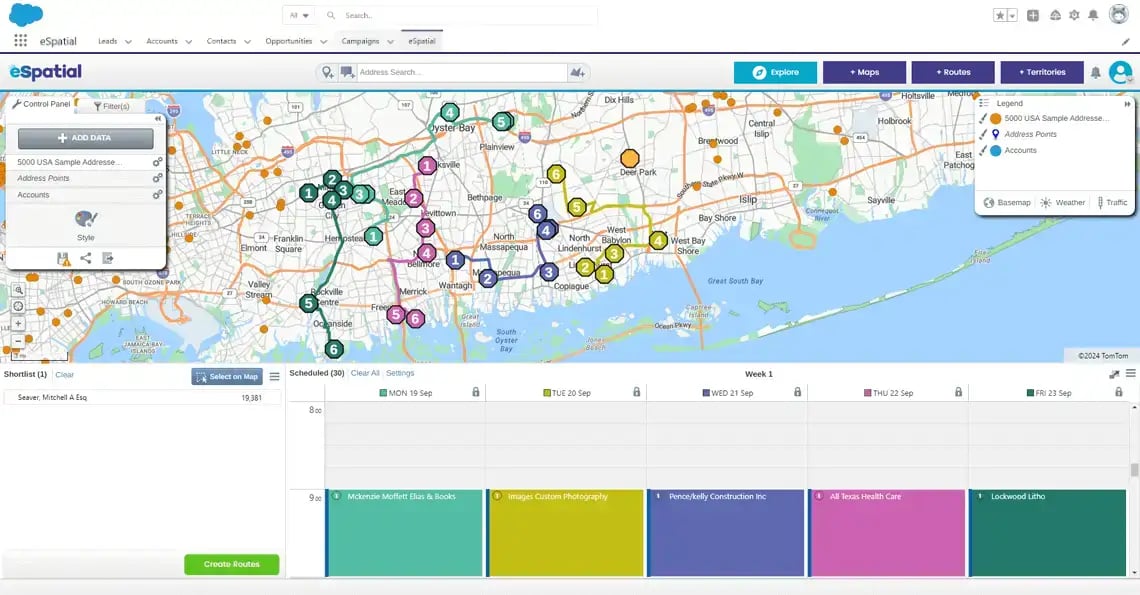
Step 7
Analyze and Refine Routes
eSpatial's sales route optimization planner uses advanced algorithms based on schedules, travel modes, and priorities. From here, it creates the best multi-day routes and can quickly re-optimize in real time if plans change.
Advanced visualizations via heat maps, priority filtering, and color-coded itineraries help sales managers understand coverage, identify high-potential areas, and distribute stops evenly across territories.
Essential Features to Look
for in a Route Planner
Here are the essential features to look for to ensure smarter routing, better time management, and stronger customer engagement.
- CRM Integration: Sync with platforms like Salesforce to effortlessly upload and visualize multiple layers of data, swiftly create dynamic reports, analyze key areas, and share the results.
- Real-Time Traffic Data: Integrate with tools like Waze or Google Maps to adjust routes based on live road conditions.
- Mobile Navigation and Data Logging: Use a native app to follow optimized routes, check in, log meeting details, and sync updates back to your CRM.
- Territory Mapping and Optimization: Divide sales regions using data like ZIP codes, customer density, and sales potential. By creating location intelligence for businesses, you can identify overlaps, gaps, and inefficiencies.
- Mileage Tracking and Reporting: Automatically calculate distances traveled for accurate reporting on expenses, performance, and compliance.
A solution like eSpatial includes all of these features and more, helping you plan smarter routes and drive better sales results.
Common Pitfalls to Avoid
in Sales Route Planning
Even the best-laid sales routes can fail without the right strategy and tools. Here are the most common pitfalls that can derail your sales route optimization planning and how to avoid them.
Pitfall 1
Relying on Manual Planning
Manual route planning in spreadsheets or basic mapping tools is time-consuming, error-prone, and limits visibility. Without automation, reps waste valuable selling time figuring out where to go next, rather than focusing on customer engagement.
Pitfall 2
Using Incomplete or Outdated Data
Planning with outdated customer lists or inaccurate location data leads to inefficient routing, missed opportunities, and wasted travel. This is why it’s so important to integrate real-time CRM and territory data to keep routes relevant and productive.
Pitfall 3
Ignoring Real-world Flexibility
Rigid plans can quickly fall apart due to cancellations, traffic, or last-minute changes. eSpatial allows reps to dynamically re-optimize routes on the go, ensuring they stay productive even when the day doesn’t go as planned.
Pitfall 4
Overloading Reps With Unrealistic Routes
Packing too many stops into a single day reduces the quality of interactions and increases burnout. eSpatial helps balance routes by factoring in meeting durations, travel time, and priorities, making routes both efficient and realistic.
Final Thoughts on Optimizing
Field Sales Route Planning
Designing a sales process through smart route planning is more than just getting from A to B. Your goal is to spend more face time with customers while reducing costs and inefficiencies. With eSpatial, teams can automate, analyze, and adapt routes based on live data, empowering reps to be more focused, responsive, and productive in the field.
Take a look at our GIS software pricing for a plan that suits your business.


